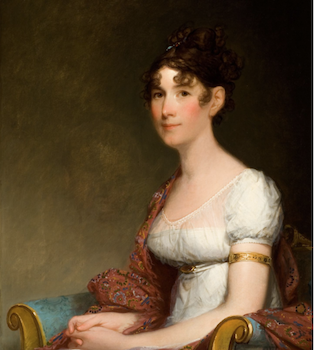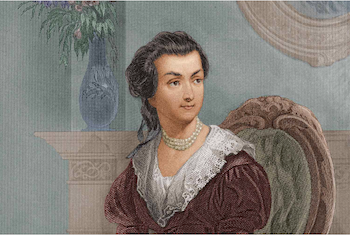
Abigail Smith Adams was born on November 22, 1744, in Weymouth, Massachusetts. She was the second child of Reverend William Smith and Elizabeth Quincy Smith. Adams’s mother was a housewife (as most women were in this age) who ensured that her children had the best upbringing. Her father, Reverend William Smith, was a renowned priest of a prestigious ministerial community. Although Adams and her two sisters, with whom she shared a strong bond, received no formal education, her mother ensured that they were proficient in literature and writing. Furthermore, Adams thought it was unfair that her older brother could receive a formal education while she could not. With this, Adams read as many books as she could from her family’s library. In addition, Adams’s sense of public duty and her values were shaped by her grandfather Colonel John Quincy, a soldier, politician, and one of the most significant citizens of the Massachusetts colony. Adams, inspired by invoking change, would constantly join her mother in tending to the poor and sickly.
Adams met John Adams through her elder sister’s fiance, Richard Cranch, and married him at the age of 19 while John was ten years her senior, causing her father to disapprove. However, Adams was persistent in the claims of “true love” and married John in a ceremony on October 25, 1964. Adams ensured that she was marrying someone of the same stature and who would respect her brilliance and ideas rather than ignore them because of her gender. After getting married, the couple moved into John’s inherited house in Braintree, a municipality in Massachusetts. Both John and Adams worked to make their life prosperous, and it paid off: John gained traction as a lawyer, and Adams became proficient at handling finances and household agendas. Throughout the course of her lifetime, Adams had five children, including John Quincy Adams, who would later go on to become the 6th president of the United States. She is given credit for single-handedly teaching her son, John Quincy, the value of individuality, ethics, and public service, which he needed to later become president. Throughout John’s lifetime, the one person who consistently supported him was Adams, demonstrating her profound impact. For example, she defended his decision to support British soldiers who were accused of causing the Boston Massacre, granting them the right to a fair trial despite being on opposing sides of liberty.

Once John fell deeper into politics and eventually went to Philadelphia to participate as a member of the First Continental Congress, Adams and John could only consistently communicate in one way: letters. This was the catalyst for the thousands of letters that were passed between them, with Adams highlighting a wide array of topics: from family life to politics. These letters showed Adams as John’s unofficial advisor and the birthplace of the majority of his ideas.
Adams is often known as an early feminist and supporter of abolition who believed that all sexes and races deserved equal treatment. However, most delegates held conservative views and rejected these ideas. Despite this, Adams continued to remain as John’s most essential confidante. Her beliefs are reinstated by her most famous message to her husband during his time working on the Declaration of Independence: “Remember the ladies” she sent in a letter to John, and warned him to “not put such unlimited power into the hands of the husbands. Remember, all men would be tyrants if they could”.

Throughout her life, Adams suffered from episodes of rheumatism, which encompasses arthritis of different joints, causing her to require a break from the fast-paced life of politics. During the last years of her life, Adams surrounded herself with family and friends, something that she had less of during her husband’s career. On October 28, 1818, Adams died due to a bout of typhoid fever. She passed away at the age of 73.
Adams made a name for herself outside of her marriage. She is a well-known supporter of women as well as the underrepresented, and she constantly injected her opinion on the current state of American politics. Her life and legacy are survived in the countless letters that were exchanged between her and John. Even without being physically present, her role as John's unofficial advisor influenced many of his decisions, so much so that Harry Truman later said that “Adams would have been a better president”. Adams, or “Mrs. President” by many Americans, was a critical figure in American society and influenced many reforming decisions. Her life left a lasting impact on the American social sphere and politics forever.
Why Did I Choose to Research Abigail Adams?
I chose to research Abigail Adams because she was an essential part of the progress that many groups, such as women, made in history. Although she was not the only early advocate for many social issues, she used her privilege as a way to influence the leader of our country to focus on all Americans, not just the ones that fit under certain categories. Although she lived centuries ago, her lasting legacy in the letters that she wrote highlights that her values transcended time and that she belongs in the narrative that she created for herself.
Works Cited
“Abigail Adams (1744.” National Parks Service, U.S. Department of the Interior, www.nps.gov/adam/learn/historyculture/abigail-adams-1744-1818.html Accessed 2 Apr. 2024.
“Abigail Adams (1744.” National Parks Service, U.S. Department of the Interior, http://www.nps.gov/adam/learn/historyculture/abigail-adams-1744-1818.htm#:~:text=In%201784%2C%20with%20independence%20and,people%20in%20Paris%20and%20London Accessed 2 Apr. 2024.
Michals, Edited by Debra. “Biography: Abigail Smith Adams.” National Women’s History Museum, http://www.womenshistory.org/education-resources/biographies/abigail-adams Accessed 2 Apr. 2024.
Sumner, Jane. “A Lively Look at Abigail Adams - and Her Sisters.” Statesman, Austin American-Statesman, 25 Sept. 2018, http://www.statesman.com/story/news/2014/03/19/a-lively-look-at-abigail-adams-and-her-sisters/10141485007/ Accessed 2 Apr. 2024.
This article was published on 6/6/24